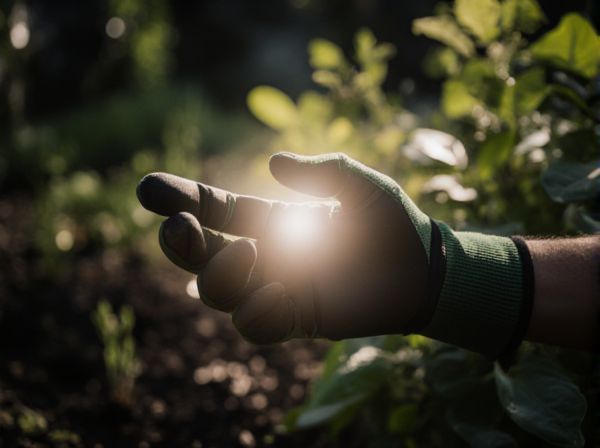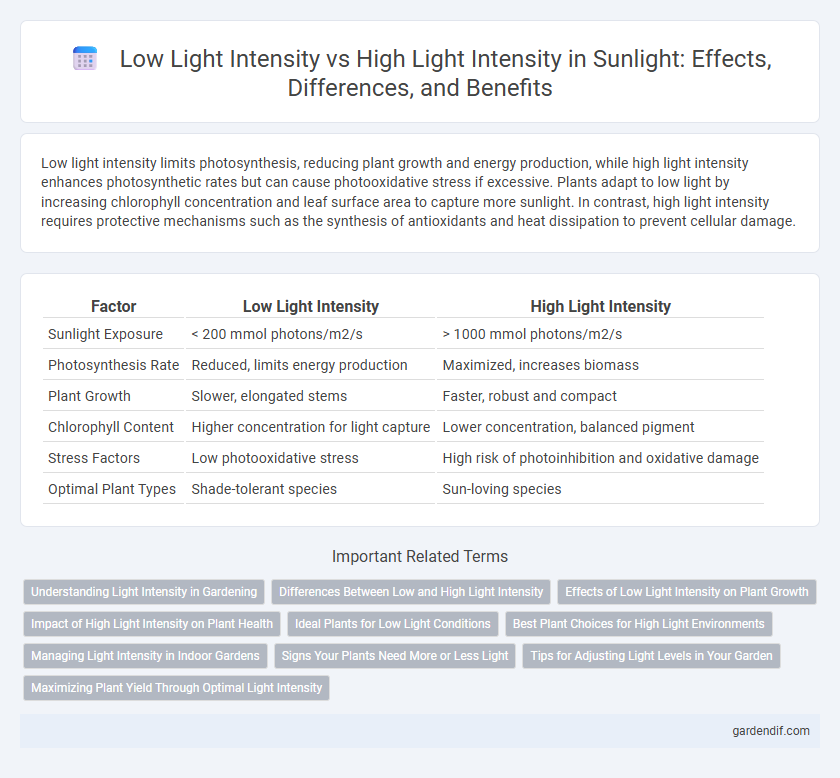
Low Light Intensity vs High Light Intensity Illustration
Low light intensity limits photosynthesis, reducing plant growth and energy production, while high light intensity enhances photosynthetic rates but can cause photooxidative stress if excessive. Plants adapt to low light by increasing chlorophyll concentration and leaf surface area to capture more sunlight. In contrast, high light intensity requires protective mechanisms such as the synthesis of antioxidants and heat dissipation to prevent cellular damage.
Table of Comparison
| Factor | Low Light Intensity | High Light Intensity |
|---|---|---|
| Sunlight Exposure | < 200 mmol photons/m2/s | > 1000 mmol photons/m2/s |
| Photosynthesis Rate | Reduced, limits energy production | Maximized, increases biomass |
| Plant Growth | Slower, elongated stems | Faster, robust and compact |
| Chlorophyll Content | Higher concentration for light capture | Lower concentration, balanced pigment |
| Stress Factors | Low photooxidative stress | High risk of photoinhibition and oxidative damage |
| Optimal Plant Types | Shade-tolerant species | Sun-loving species |
Understanding Light Intensity in Gardening
Light intensity plays a crucial role in gardening, affecting photosynthesis rates and plant growth. Low light intensity limits energy availability, leading to slower growth and leggy or pale plants, while high light intensity enhances chlorophyll production and boosts overall health. Understanding the optimal light intensity for specific plant species ensures healthy development and maximizes yields in gardens.
Differences Between Low and High Light Intensity
Low light intensity results in reduced photosynthesis rates, causing slower plant growth and lower energy production, while high light intensity enhances photosynthesis, boosting growth and biomass accumulation. Low light environments often trigger plants to develop larger leaves for increased light capture, whereas high light exposure leads to smaller, thicker leaves optimized for light utilization and protection from excess radiation. These differences in physiological and morphological adaptations between low and high light intensities significantly impact plant productivity, survival strategies, and ecosystem dynamics.
Effects of Low Light Intensity on Plant Growth
Low light intensity significantly reduces photosynthesis rates, leading to slower plant growth and elongated, weak stems as plants stretch towards available light sources. Insufficient light also limits chlorophyll production, causing pale or yellowing leaves and decreased energy accumulation for development. Prolonged exposure to low light conditions results in stunted growth, reduced flowering, and lower overall crop yield.
Impact of High Light Intensity on Plant Health
High light intensity significantly enhances photosynthesis rates, driving increased biomass production in many plant species. However, excessive sunlight can cause photoinhibition, leading to chlorophyll degradation and reduced photosynthetic efficiency. Prolonged exposure to intense light often results in oxidative stress, damaging cellular structures and impairing overall plant health.
Ideal Plants for Low Light Conditions
Low light intensity environments are suitable for shade-tolerant plants such as snake plants, pothos, and peace lilies, which thrive with minimal sunlight. These plants have adapted to photosynthesize efficiently under limited light, making them ideal for indoor spaces or shaded garden areas. In contrast, high light intensity plants like succulents and cacti require direct sunlight to grow optimally and might suffer in low light conditions.
Best Plant Choices for High Light Environments
Succulents such as Aloe Vera, Agave, and Echeveria thrive in high light intensity due to their ability to store water and tolerate direct sunlight. Other excellent choices include cacti and sun-loving herbs like rosemary and basil, which have adapted to strong sunlight with robust, waxy leaves. These plants exhibit enhanced photosynthesis rates and growth in environments with intense sunlight, making them ideal for bright, sunny locations.
Managing Light Intensity in Indoor Gardens
Managing light intensity in indoor gardens requires balancing low light intensity, which limits photosynthesis and slows plant growth, with high light intensity that can cause leaf burn and stress. Using adjustable LED grow lights allows precise control over light spectrum and intensity, optimizing plant health and development. Monitoring plants' responses and adjusting distances between lights and foliage ensures effective light management in enclosed environments.
Signs Your Plants Need More or Less Light
Yellowing leaves and leggy growth are common signs your plants need more light, indicating insufficient photosynthesis and energy production. Conversely, scorched or bleached leaf edges and wilting suggest exposure to high light intensity, causing stress and damage to the plant tissues. Monitoring leaf color, growth patterns, and moisture levels helps determine whether to adjust light exposure for optimal plant health.
Tips for Adjusting Light Levels in Your Garden
Managing light intensity in your garden is crucial for optimal plant growth; low light intensity may lead to elongated stems and poor flowering, while high light intensity can cause leaf scorching and dehydration. Use shading techniques such as shade cloths or strategically planting taller plants to reduce excessive light exposure, and consider reflective surfaces or supplemental grow lights to enhance light availability in low-light areas. Regularly monitor your plants' response to adjustments and modify light levels to align with the specific needs of each species for healthy development.
Maximizing Plant Yield Through Optimal Light Intensity
Maximizing plant yield through optimal light intensity involves balancing photosynthetic efficiency and energy use by avoiding low light levels that limit growth and high light intensities that cause photoinhibition. Low light intensity reduces chlorophyll activity and slows biomass accumulation, while excessively high light can damage chloroplasts and decrease overall productivity. Research shows that maintaining moderate light intensity between 400 to 800 umol photons m^-2 s^-1 maximizes photosynthesis rates and optimizes crop yield.
Low Light Intensity vs High Light Intensity Infographic

 gardendif.com
gardendif.com